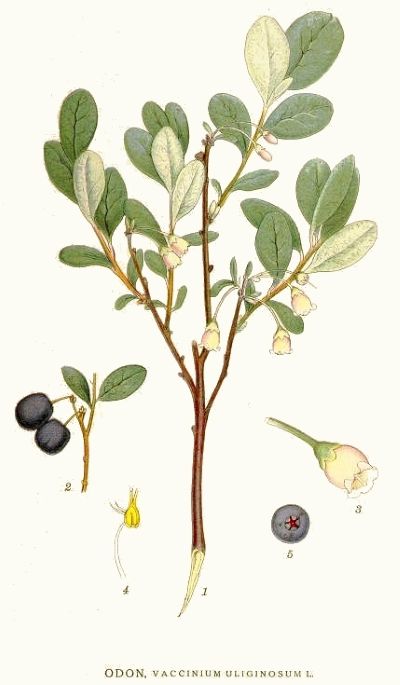Common Blueberry
- Description of Blueberry
- Distribution and Ecology of Blueberry
- Raw Materials from Blueberry
- Chemical Composition of Blueberry
- Uses and Benefits of Blueberry
- Precautions for Using Blueberry
- Contraindications for Using Blueberry
- Medicinal Recipes with Blueberry
- Cosmetic Uses of Blueberry
- Culinary Uses of Blueberry
Common Blueberry
Vaccinium uliginosum L.
Ericaceae Family
Description of Blueberry
Common blueberry low shrub 11.8–39.4 in (30–100 cm) gray-brown bark spreading branches. Leaves alternate elliptical 0.4–1.2 in (1–3 cm) bluish-green smooth autumn red. Flowers jug-shaped white pinkish 0.16–0.24 in (4–6 mm) small clusters. Fruits round berries 0.24–0.39 in (6–10 mm) blue-black bluish bloom juicy small seeds. Varieties: ‘Northern’ ‘Bluecrop’ ‘Patriot’. Blooms May–June fruits July–August.
Distribution and Ecology of Blueberry
Blueberry Northern Europe Siberia Far East North America bogs coniferous forests tundra up 9843 ft (3000 m). Cultivated Russia Poland Canada USA. Acid peat soils (pH 3.5 acid–5.0) semi-shade watering 10–15 l/m² every 7–10 days. Propagates seeds cuttings division. Yield: 2.2–6.6 lb/bush (1–3 kg). Care: mulching sulfur feed (10–15 g/m²) protect gray mold birds. Landscaping soil stabilization.
Raw Materials from Blueberry
Raw: fruits (fructus Vaccinii uliginosi) leaves (folia). Fruits July–August dry 104–122°F (40–50°C) (yield 15–20%). Leaves June–July dry 104°F (40°C) (yield 20–25%). Quality: fruits blue-black no mold; leaves green; humidity ≤12%. Store sealed (fruits 1 year; leaves 1 year). Smell weak taste sour-sweet.
Chemical Composition of Blueberry
Fruits: water (85%) sugars (8%) organic acids (malic citric 2%) pectins (1%) vitamin C (40 mg%) A E K anthocyanins (1.5%) flavonoids minerals (K Mn Fe). Leaves: flavonoids tannins (3%) vitamin C (100 mg%). Calories: 35–40 kcal/100 g.
Uses and Benefits of Blueberry
Antioxidant anti-inflammatory diuretic hypoglycemic tonic. Diabetes anemia hypertension UTIs vision gastritis colds. Fruits improve sight strengthen vessels digestion. Leaves lower blood sugar throat inflammation. Juice boosts immunity lowers cholesterol.
Precautions for Using Blueberry
>2.2 lb/day (1 kg) fruits >6.8 oz/day (200 ml) juice diarrhea flatulence. Store juice 32–41°F (0–5°C) ≤24 hours. Children under 3 ≤1.76 oz/day (50 g). Wash berries pesticides. Prolonged leaf infusions (>2 weeks) monitor blood sugar.
Contraindications for Using Blueberry
Allergy Ericaceae oxalate kidney stones pancreatitis high-acid gastritis pregnancy lactation.
Medicinal Recipes with Blueberry
- Leaf infusion diabetes. Steep 0.35 oz (10 g) leaves 6.8 oz (200 ml) boiling 20 min drink 1.7 oz (50 ml) 2 times day 10 days.
- Fruit decoction anemia. Boil 0.7 oz (20 g) dried fruits 6.8 oz (200 ml) water 10 min drink 1.7 oz (50 ml) 3 times day 7 days.
- Juice hypertension. Drink 1.7 oz (50 ml) juice 2 times day 10 days.
- Poultice skin inflammation. Apply 0.7 oz (20 g) pulp 15 min rinse 2 times day 5 days.
Cosmetic Uses of Blueberry
Skin care.
- Rejuvenating mask. 0.7 oz (20 g) pulp 0.34 oz (10 ml) honey apply 15 min rinse 2 times week.
- Oily skin lotion. 0.68 oz (20 ml) juice 0.34 oz (10 ml) water wipe skin once day.
- Moisturizing mask. 0.7 oz (20 g) pulp 0.34 oz (10 ml) yogurt apply 20 min rinse 2 times week.
- Leaf infusion acne. Steep 0.35 oz (10 g) leaves 3.4 oz (100 ml) boiling 20 min wipe skin 2 times day.
Culinary Uses of Blueberry
Fresh dried desserts drinks.
- Compote. 7 oz (200 g) fruits 33.8 oz (1 l) water 1.76 oz (50 g) sugar boil 10 min.
- Jam. 2.2 lb (1 kg) fruits 1.76 lb (800 g) sugar 6.8 oz (200 ml) water cook 30 min jar.
- Smoothie. Blend 7 oz (200 g) fruits 3.4 oz (100 ml) yogurt 0.35 oz (10 g) honey.
- Leaf tea. Steep 0.35 oz (10 g) dried leaves 6.8 oz (200 ml) boiling 5 min.
Tips: Store fruits 32–41°F (0–5°C) 1 month dried 1 year. Soak dried 1–2 hours before cooking.
Other Other Properties of Blueberry
Landscaping honey plant bog soil stabilization.




